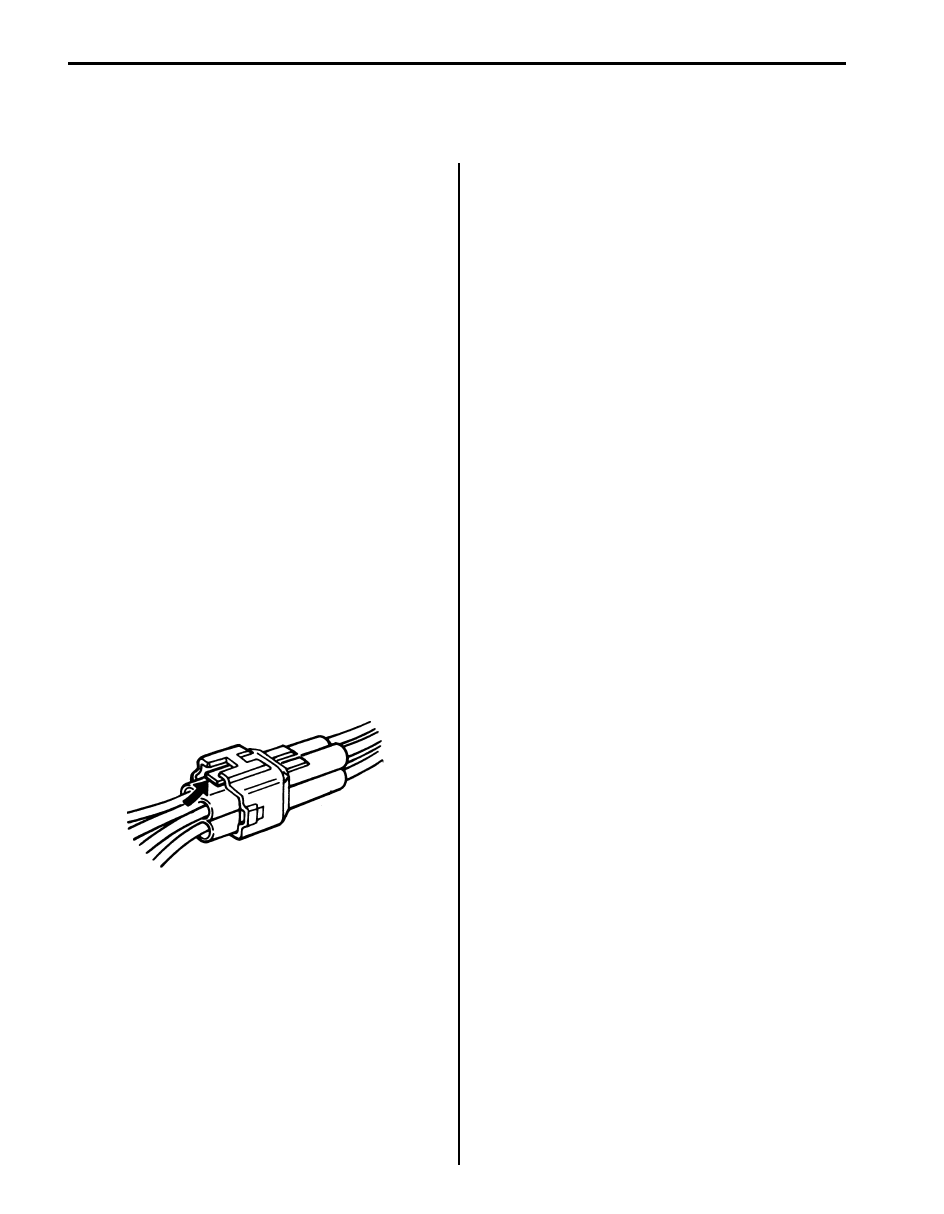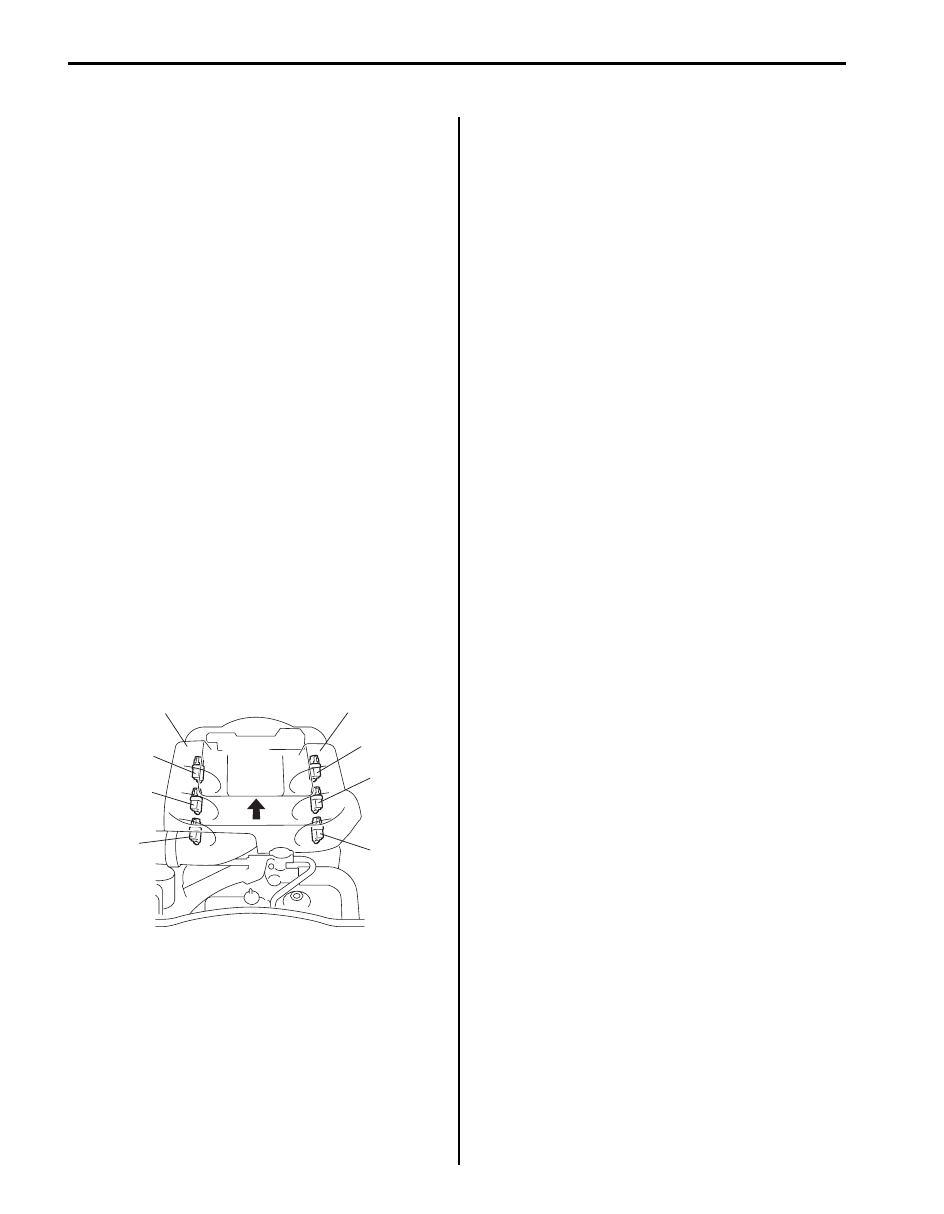Suzuki Grand Vitara JB627. Manual — part 13

1A-1 Engine General Information and Diagnosis:
Engine
Engine General Information and Diagnosis
Precautions
Precautions on Engine Service
S6JB0B1100001
The following information on engine service should be
noted carefully, as it is important in preventing damage,
and in contributing to reliable engine performance.
• When raising or supporting engine for any reason, do
not use a jack under oil pan. Due to small clearance
between oil pan and oil pump strainer, jacking against
oil pan may cause it to be bent against strainer
resulting in damaged oil pick-up unit.
• It should be kept in mind, while working on engine,
that 12-volt electrical system is capable of violent and
damaging short circuits. When performing any work
where electrical terminals could possibly be
grounded, ground cable of the battery should be
disconnected at battery.
• Any time the air cleaner, air intake pipe, throttle body
or intake manifold is removed, the intake opening
should be covered. This will protect against accidental
entrance of foreign material which could follow intake
passage into cylinder and cause extensive damage
when engine is started.
• When disconnecting couplers, don’t pull wire harness
but make sure to hold coupler itself. With lock type
coupler, be sure to unlock before disconnection.
Attempt to disconnect coupler without unlocking may
result in damage to coupler. When connecting lock
type coupler, insert it till clicking sound is heard and
connect it securely.
Precautions in Diagnosing Trouble
S6JB0B1100002
• Don’t disconnect couplers from ECM, battery cable
from battery, ECM ground wire harness from engine
or main fuse before confirming diagnostic information
(DTC, freeze frame data, etc.) stored in ECM memory.
Such disconnection will erase memorized information
in ECM memory.
• Diagnostic information stored in ECM memory can be
cleared as well as checked by using SUZUKI scan
tool or OBD generic scan tool. Before using scan tool,
read its Operator’s (Instruction) Manual carefully to
have good understanding as to what functions are
available and how to use it.
• It is indistinguishable which module turns on MIL
because not only ECM but also TCM (A/T model)
turns on MIL (For details of on-board diagnostic
system for A/T model, refer to “On-Board Diagnostic
System Description in Section 5A”). Therefore, check
both ECM and TCM (A/T model) for DTC when MIL
lights on. When checking ECM for DTC, keep in mind
that DTC is displayed on the scan tool as follows
depending on the scan tool used.
– SUZUKI scan tool displays DTC detected by ECM.
– OBD generic scan tool displays DTC detected by
each of ECM and TCM (A/T model) simultaneously.
• Priorities for diagnosing troubles
If two or more diagnostic trouble codes (DTCs) are
stored, proceed to the flow of the DTC which has
detected earliest in the order and follow the instruction
in that table.
If no instructions are given, troubleshoot diagnostic
trouble codes according to the following priorities.
a. Diagnostic trouble codes (DTCs) other than DTC
P0171 / P0172 / P0174 / P0175 (Fuel system too
lean/too rich), DTC P0300 / P0301 / P0302 /
P0303 / P0304 / P0305 / P0306 (Misfire detected)
and DTC P0401 / P0402 (EGR flow malfunction)
b. DTC P0171 / P0172 / P0174 / P0175 (Fuel
system too lean/too rich) and DTC P0401 / P0402
(EGR flow malfunction)
c. DTC P0300 / P0301 / P0302 / P0303 / P0304 /
P0305 / P0306 (Misfire detected)
IYSQ01110001-01

Engine General Information and Diagnosis: 1A-2
• Be sure to read “Precaution for CAN Communication
System in Section 00” before inspection and observe
what is written there.
• ECM Replacement
When substituting a known good ECM, check for the
following conditions. Neglecting this check may cause
damage to known good ECM.
– Resistance value of all relays, actuators is as
specified respectively.
– MAF sensor MAP sensor, TP sensor and A/C
refrigerant pressure sensor are in good condition
and none of power circuits of these sensors is
shorted to ground.
• Communication of ECM, BCM, combination meter,
keyless start control module (if equipped), ABS or
ESP
® control module, 4WD control module (if
equipped), steering angle sensor (ESP
® model) and
TCM (A/T model), is established by CAN (Controller
Area Network). (For more detail of CAN
communication for ECM, refer to “CAN
Communication System Description”). Therefore,
handle CAN communication line with care referring to
“Precaution for CAN Communication System in
Section 00”.
• Immobilizer transponder code registration after
replacing ECM.
When ECM is replaced with new one or with another
one, make sure to register immobilizer transponder
code to ECM correctly according to “Procedure after
ECM Replacement in Section 10C”.
Precautions for DTC Troubleshooting
S6JB0B1100003
• Before performed trouble shooting, be sure to read
the “Precautions of ECM Circuit Inspection”.
• When measuring circuit voltage, resistance and/or
pulse signal at ECM connector, connect the special
tool to ECM and/or the ECM connectors referring to
“Inspection of ECM and Its Circuits”.
• Upon completion of inspection and repair work,
perform “DTC Confirmation Procedure” and confirm
that the trouble has been corrected.
Precautions of ECM Circuit Inspection
S6JB0B1100004
• ECM connectors are waterproofed. Each terminal of
the ECM connectors is sealed up with the grommet.
Therefore, when measuring circuit voltage, resistance
and/or pulse signal at ECM connector, do not insert
the tester’s probe into the sealed terminal at the
harness side. When measuring circuit voltage,
resistance and/or pulse signal at ECM connector,
connect the special tool to the ECM connectors. And,
insert the tester’s probe into the special tool’s
connectors at the harness side, and then measure
voltage, resistance and/or pulse signal. Or, ECM and
its circuits may be damaged by water.
• Wire colors of the special tool’s connectors are
different from the ones of the ECM connectors.
However, the circuit arrangement of the special tool’s
connectors is same as the one of the ECM
connectors. Therefore, measure circuit voltage and
resistance by identifying the terminal location subject
to the measurement.
Precautions of Electric Throttle Body System
Calibration
S6JB0B1100005
After performing one of works described below, it is
necessary to re-register the completely closed throttle
valve reference position stored in memory of ECM. (For
detailed information, refer to “Description of Electric
Throttle Body System Calibration”.) For the procedure to
register such data in ECM, refer to “Electric Throttle
Body System Calibration in Section 1C”.
• To shut off backup power of ECM for such purposes of
battery replacement or “DOME” fuse removal.
• To erase DTCs P0122, P0123, P0222, P0223, P2101,
P2102, P2103, P2108, P2119 and/or P2135.
• To replace ECM.
• To replace throttle body and/or accelerator pedal
position (APP) sensor assembly.

1A-3 Engine General Information and Diagnosis:
General Description
Statement of Cleanliness and Care
S6JB0B1101001
An automobile engine is a combination of many
machined, honed, polished and lapped surfaces with
tolerances that are measured in the thousands of an
millimeter (ten thousands of inch). Accordingly, when
any internal engine parts are serviced, care and
cleanliness are important. Throughout this section, it
should be understood that proper cleaning and
protection of machined surfaces and friction areas is part
of the repair procedure. This is considered standard
shop practice even if not specifically stated.
• A liberal coating of engine oil should be applied to
friction areas during assembly to protect and lubricate
the surface on initial operation.
• Whenever valve train components, pistons, piston
rings, connecting rods, rod bearings and crankshaft
journal bearings are removed for service, they should
be retained in order. At the time of installation, they
should be installed in the same locations and with the
same mating surfaces as when removed.
• Battery cables should be disconnected before any
major work is performed on the engine. Failure to
disconnect cables may result in damage to wire
harness or other electrical parts.
• Throughout this manual, the 6 cylinders of the engine
are identified by numbers;
No.1 (1), No.3 (3) and No.5 (5) of LH bank (7) and
No.2 (2), No.4 (4) and No.6 (6) of RH bank (8) as
counted from crankshaft pulley side (9) to flywheel
side (10).
Engine Diagnosis General Description
S6JB0B1101002
This vehicle is equipped with an engine and emission
control system which are under control of ECM.
The engine and emission control system in this vehicle
are controlled by ECM. ECM has an On-Board
Diagnostic system which detects a malfunction in this
system and abnormality of those parts that influence the
engine exhaust emission. When diagnosing engine
troubles, be sure to have full understanding of the outline
of “On-Board Diagnostic System Description” and each
item in “Precautions in Diagnosing Trouble” and execute
diagnosis according to “Engine and Emission Control
System Check”.
There is a close relationship between the engine
mechanical, engine cooling system, ignition system,
exhaust system, etc. and the engine and emission
control system in their structure and operation. In case of
an engine trouble, even when the malfunction indicator
lamp (MIL) doesn’t turn ON, it should be diagnosed
according to “Engine and Emission Control System
Check”.
On-Board Diagnostic System Description
S6JB0B1101003
ECM in this vehicle has the following functions.
• When the ignition switch is turned ON with the engine
at a stop, MIL (1) turns ON to check the malfunction
indicator lamp (MIL) (1) and its circuit.
• When ECM detects a malfunction which gives an
adverse effect to vehicle emission while the engine is
running, it makes the malfunction indicator lamp in the
meter cluster of the instrument panel turn ON or flash
(flashing only when detecting a misfire which can
cause damage to the catalyst) and stores the
malfunction area (DTC according to SAE J2012) in its
memory.
(If it detects that continuously 3 driving cycles are
normal after detecting a malfunction, however, it
makes MIL turn OFF although DTC stored in its
memory will remain.)
• As a condition for detecting a malfunction in some
areas in the system being monitored by ECM and
turning ON the malfunction indicator lamp due to that
malfunction, 2 driving cycle detection logic is adopted
to prevent erroneous detection.
• When a malfunction is detected, engine and driving
conditions then are stored in ECM memory as freeze
frame data. (For the details, refer to description on
Freeze frame data.)
7
5
3
1
9
10
2
4
6
8
I6JB01110007-02

Engine General Information and Diagnosis: 1A-4
• It is possible to communicate via DLC (data link
connector) (2) by using not only SUZUKI scan tool (3)
but also OBD generic scan tool.
Warm-Up Cycle
A warm-up cycle means sufficient vehicle operation such
that the coolant temperature has risen by at least 22
°C
(40
°F) from engine starting and reaches a minimum
temperature of 70
°C (160 °F).
Driving Cycle
A “Driving Cycle” consists of engine startup driving mode
where a malfunction would be detected if present and
next engine startup.
2 Driving Cycle Detection Logic
The malfunction detected in the first driving cycle is
stored in ECM memory (in the form of pending DTC and
freeze frame data) but the malfunction indicator lamp
does not light at this time. It lights up at the second
detection of same malfunction also in the next driving
cycle.
Pending DTC
Pending DTC means a DTC detected and stored
temporarily at 1 driving cycle of the DTC which is
detected in the 2 driving cycle detection logic.
Freeze Frame Data
ECM stores the engine and driving conditions (in the
form of data as shown) at the moment of the detection of
a malfunction in its memory. This data is called “Freeze
frame data”.
Therefore, it is possible to know engine and driving
conditions (e.g., whether the engine was warm or not,
where the vehicle was running or stopped, where air/fuel
mixture was lean or rich) when a malfunction was
detected by checking the freeze frame data. Also, ECM
has a function to store each freeze frame data for three
different malfunctions in the order as the malfunction is
detected. Utilizing this function, it is possible to know the
order of malfunctions that have been detected. Its use is
helpful when rechecking or diagnosing a trouble.
An example of freeze frame data
1
(A)
1
I5JB0C110019-02
[A]: 1st, 2nd or 3rd in parentheses here represents which position in the
order the malfunction is detected.
[A]
I5JA01112021-01

Нет комментариевНе стесняйтесь поделиться с нами вашим ценным мнением.
Текст